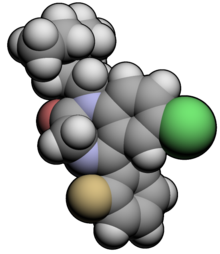- Flurazepam
-
Flurazepam 

Systematic (IUPAC) name 7-chloro-1-[2-(diethylamino)ethyl]-5-(2-fluorophenyl)-1,3-dihydro-2H-1,4-benzodiazepin-2-one Clinical data Trade names Dalmane AHFS/Drugs.com monograph MedlinePlus a682051 Pregnancy cat. X (Contraindicated in pregnancy) Legal status Schedule IV (US) Routes Oral Pharmacokinetic data Bioavailability 83% Metabolism Hepatic Half-life 40–250 hours Excretion Renal Identifiers CAS number 17617-23-1 
ATC code N05CD01 PubChem CID 3393 DrugBank APRD00983 ChemSpider 3276 
UNII IHP475989U 
KEGG D00329 
ChEMBL CHEMBL968 
Chemical data Formula C21H23ClFN3O Mol. mass 387.88 g/mol SMILES eMolecules & PubChem Physical data Melt. point 79.5 °C (175 °F)  (what is this?) (verify)
(what is this?) (verify)Flurazepam[1] (marketed under the brand names Dalmane and Dalmadorm) is a drug which is a benzodiazepine derivative. It possesses anxiolytic, anticonvulsant, sedative and skeletal muscle relaxant properties. It produces a metabolite with a very long half-life (40–250 hours), which may stay in the bloodstream for up to four days.[1] Flurazepam is therefore unsuitable as a sleeping medication for some individuals due to next day sedation.
Contents
Indications
Flurazepam is officially indicated for mild to moderate insomnia and as such it is used for short-term treatment of patients with mild to moderate insomnia such as difficulty falling asleep, frequent awakening, early awakenings or a combination of each. Flurazepam is a long acting benzodiazepine and is sometimes used in patients who have difficulty in maintaining sleep. Intermediate half-life benzodiazepines are also useful for patients with difficulty in maintaining sleep (e.g. loprazolam, lormetazepam, temazepam). Hypnotics should only be used on a short term basis or in those with chronic insomnia on an occasional basis.[2]
Side effects
The most common adverse effects are dizziness, drowsiness, lightheadedness, and ataxia. Flurazepam has abuse potential and should never be used with alcohol or any other substance that can cause drowsiness. Additive and possibly fatal results may occur. Flurazepam users should only take this drug strictly as prescribed, and should only be taken directly before the user plans on sleeping a full night. Next day drowsiness is common and may increase during the initial phase of treatment as accumulation occurs until steady-state plasma levels are attained.
Tolerance, dependence and withdrawal problems
Main article: Benzodiazepine withdrawal syndromeA review paper found that long term use of flurazepam is associated with drug tolerance, drug dependence, rebound insomnia and CNS related adverse effects. Flurazepam is best used for a short time period and at the lowest possible dose to avoid complications associated with long term use. Non-pharmacological treatment options however, were found to have sustained improvements in sleep quality.[3] Flurazepam and other benzodiazepines such as fosazepam, and nitrazepam lost some of their effect after seven days administration in psychogeriatric patients.[4] Flurazepam shares cross tolerance with barbiturates and barbiturates can easily be substituted by flurazepam in those who are habituated to barbiturate sedative hypnotics.[5]
After discontinuation of flurazepam a rebound effect or benzodiazepine withdrawal syndrome may occur about four days after discontinuation of medication.[6]
Contraindications and special caution
Benzodiazepines require special precaution if used in the elderly, during pregnancy, in children, alcohol- or drug-dependent individuals and individuals with comorbid psychiatric disorders.[7]
Elderly
Flurazepam, similar to other benzodiazepines and nonbenzodiazepine hypnotic drugs causes impairments in body balance and standing steadiness in individuals who wake up at night or the next morning. Falls and hip fractures are frequently reported. The combination with alcohol increases these impairments. Partial, but incomplete tolerance develops to these impairments.[8] An extensive review of the medical literature regarding the management of insomnia and the elderly found that there is considerable evidence of the effectiveness and durability of non-drug treatments for insomnia in adults of all ages and that these interventions are underutilized. Compared with the benzodiazepines including flurazepam, the nonbenzodiazepine sedative-hypnotics appeared to offer few, if any, significant clinical advantages in efficacy in elderly persons. Tolerability in elderly patients, however, is improved marginally in that benzodiazepines have moderately higher risks of falls, memory problems, and disinhibition ("Paradoxical agitation") when compared to non-benzodiazepine sedatives. It was found that newer agents with novel mechanisms of action and improved safety profiles, such as the melatonin agonists, hold promise for the management of chronic insomnia in elderly people. Chronic use of sedative-hypnotic drugs for the management of insomnia does not have an evidence base and has been discouraged due to concerns including potential adverse drug effects as cognitive impairment (anterograde amnesia), daytime sedation, motor incoordination, and increased risk of motor vehicle accidents and falls. In addition, the effectiveness and safety of long-term use of sedative hypnotics has been determined to be no better than placebo after 3 months of therapy and worse than placebo after 6 months of therapy. (NEJM, 1983, 1994, et seq.)[9]
Pharmacology
Flurazepam is a "classical" benzodiazepine, other classical benzodiazepines include; diazepam, clonazepam, oxazepam, lorazepam, nitrazepam, bromazepam and clorazepate.[10] Flurazepam generates an active metabolite with a very long elimination half-life of 40–250 hours. Residual 'hangover' effects after nighttime administration of flurazepam, such as sleepiness, impaired psychomotor and cognitive functions, may persist into the next day, which may impair the ability of users to drive safely and increase risks of falls and hip fractures.[11]
Flurazepam is lipophilic, is metabolised hepatically via oxidative pathways. The main pharmacological effect of flurazepam is to increase the effect of GABA at the GABAA receptor via binding to the benzodiazepine site on the GABAA receptor causing an increase influx of chloride ions into the GABAA neuron.[12][13] Flurazepam is a unique benzodiazepine in that it is a partial agonist of benzodiazepine receptors whereas other benzodiazepines are full agonists of benzodiazepine receptors.[14]
Flurazepam is contraindicated in pregnancy. It is recommended to withdraw flurazepam during breast feeding, as flurazepam is excreted in breast milk.[15]
Drug misuse
See also: Benzodiazepine drug misuseFlurazepam is a drug with potential for misuse. Two types of drug misuse can occur, either recreational misuse where the drug is taken to achieve a high, or when the drug is continued long term against medical advice.[16]
Legal status
Flurazepam is a Schedule IV drug under the Convention on Psychotropic Substances.[2]
See also
- Long-term effects of benzodiazepines
References
- ^ BE Patent 629005
- ^ Rickels K. (1986). "The clinical use of hypnotics: indications for use and the need for a variety of hypnotics". Acta Psychiatrica Scandinavica Suppl. 332: 132–41. doi:10.1111/j.1600-0447.1986.tb08990.x. PMID 2883820.
- ^ Kirkwood CK (1999). "Management of insomnia". J Am Pharm Assoc (Wash) 39 (5): 688–96; quiz 713–4. PMID 10533351.
- ^ Viukari M; Linnoila M, Aalto U. (January 1978). "Efficacy and side effects of flurazepam, fosazepam, and nitrazepam as sleeping aids in psychogeriatric patients". Acta Psychiatrica Scandinavica 57 (1): 27–35. doi:10.1111/j.1600-0447.1978.tb06871.x. PMID 24980.
- ^ Rooke KC. (1976). "The use of flurazepam (dalmane) as a substitute for barbiturates and methaqualone/diphenhydramine (mandrax) in general practice". J Int Med Res. 4 (5): 355–9. PMID 18375.
- ^ Hindmarch I. (November 1977). "A repeated dose comparison of three benzodiazepine derivative (nitrazepam, flurazepam and flunitrazepam) on subjective appraisals of sleep and measures of psychomotor performance the morning following night-time medication". Acta Psychiatrica Scandinavica 56 (5): 373–81. doi:10.1111/j.1600-0447.1977.tb06678.x. PMID 22990.
- ^ Authier, N.; Balayssac, D.; Sautereau, M.; Zangarelli, A.; Courty, P.; Somogyi, AA.; Vennat, B.; Llorca, PM. et al. (November 2009). "Benzodiazepine dependence: focus on withdrawal syndrome.". Ann Pharm Fr 67 (6): 408–13. doi:10.1016/j.pharma.2009.07.001. PMID 19900604.
- ^ Mets, MA.; Volkerts, ER.; Olivier, B.; Verster, JC. (Feb 2010). "Effect of hypnotic drugs on body balance and standing steadiness.". Sleep Med Rev 14 (4): 259–67. doi:10.1016/j.smrv.2009.10.008. PMID 20171127.
- ^ Bain KT (June 2006). "Management of chronic insomnia in elderly persons". Am J Geriatr Pharmacother 4 (2): 168–92. doi:10.1016/j.amjopharm.2006.06.006. PMID 16860264.
- ^ Braestrup C; Squires RF. (1 April 1978). "Pharmacological characterization of benzodiazepine receptors in the brain". Eur J Pharmacol 48 (3): 263–70. doi:10.1016/0014-2999(78)90085-7. PMID 639854.
- ^ Vermeeren A. (2004). "Residual effects of hypnotics: epidemiology and clinical implications". CNS Drugs. 18 (5): 297–328. doi:10.2165/00023210-200418050-00003. PMID 15089115.
- ^ Oelschläger H. (July 4, 1989). "[Chemical and pharmacologic aspects of benzodiazepines]". Schweiz Rundsch Med Prax. 78 (27-28): 766–72. PMID 2570451.
- ^ Lehoullier PF, Ticku MK (March 1987). "Benzodiazepine and beta-carboline modulation of GABA-stimulated 36Cl-influx in cultured spinal cord neurons". Eur. J. Pharmacol. 135 (2): 235–8. doi:10.1016/0014-2999(87)90617-0. PMID 3034628.
- ^ Chan CY; Farb DH (1 September 1985). "Modulation of neurotransmitter action: control of the gamma-aminobutyric acid response through the benzodiazepine receptor" (PDF). J Neurosci 5 (9): 2365–73. PMID 2863335. http://www.jneurosci.org/cgi/reprint/5/9/2365.
- ^ Olive G; Dreux C. (January 1977). "Pharmacologic bases of use of benzodiazepines in peréinatal medicine". Arch Fr Pediatr. 34 (1): 74–89. PMID 851373.
- ^ Griffiths RR, Johnson MW (2005). "Relative abuse liability of hypnotic drugs: a conceptual framework and algorithm for differentiating among compounds". J Clin Psychiatry 66 Suppl 9: 31–41. PMID 16336040.
External links
Benzodiazepine derivatives 1,4-Benzodiazepines Bromazepam · Camazepam · Carburazepam · Chlordiazepoxide · Cinolazepam · Clonazepam · Clorazepate · Cyprazepam · Delorazepam · Demoxepam · Devazepide * · Diazepam · Doxefazepam · Elfazepam · Ethyl carfluzepate · Ethyl dirazepate · Ethyl loflazepate · Fletazepam · Fludiazepam · Flunitrazepam · Flurazepam · Flutemazepam · Flutoprazepam · Fosazepam · Gidazepam · Halazepam · Iclazepam · Ketazolam · Lorazepam · Lormetazepam · Meclonazepam · Medazepam · Menitrazepam · Metaclazepam · Motrazepam · Nimetazepam · Nitrazepam · Nitrazepate · Nordazepam · Nortetrazepam · Oxazepam · Phenazepam · Pinazepam · Pivoxazepam · Prazepam · Proflazepam · Quazepam · QH-II-66 · Reclazepam · Ro5-2904 · Ro5-4864 * · Sulazepam · Temazepam · Tetrazepam · Tifluadom * · Tolufazepam · Tuclazepam · Uldazepam
1,5-Benzodiazepines Arfendazam · Clobazam · CP-1414S · Lofendazam · Triflubazam
2,3-Benzodiazepines * Girisopam · GYKI-52466 · GYKI-52895 · Nerisopam · Talampanel · Tofisopam
Triazolobenzodiazepines Adinazolam · Alprazolam · Estazolam · Flubromazolam · Triazolam
Imidazobenzodiazepines Bretazenil · Climazolam · FG-8205 · Flumazenil · Imidazenil · L-655,708 · Loprazolam · Midazolam · PWZ-029 · Remimazolam · Ro15-4513 · Ro48-6791 · Ro48-8684 · Sarmazenil · SH-053-R-CH3-2′F
Oxazolobenzodiazepines Cloxazolam · Flutazolam · Haloxazolam · Mexazolam · Oxazolam
Thienodiazepines Bentazepam · Brotizolam · Ciclotizolam · Clotiazepam · Etizolam · Olanzapine *
Pyridodiazepines Lopirazepam · Zapizolam
Pyrazolodiazepines Pyrrolodiazepines Tetrahydroisoquinobenzodiazepines Benzodiazepine prodrugs * atypical activity profile (not GABAA receptor ligands)Categories:- Anticonvulsants
- Anxiolytics
- Benzodiazepines
- Hypnotics
- Sedatives
- Organochlorides
- Organofluorides
- Lactams
Wikimedia Foundation. 2010.

